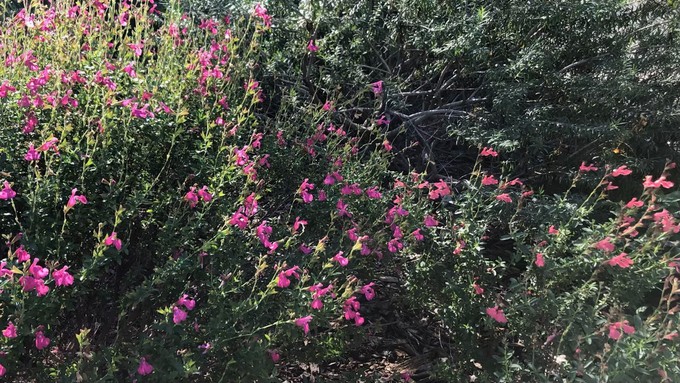
Find great deals on water-wise shrubs, perennials and trees including Arboretum All-Stars

Fans of salvias can find many varieties of the perennial shrub at the UC Davis Teaching Nursery clearance sale this weekend. The ones shown here grow just outside the nursery. Kathy Morrison
Early November offers prime planting conditions, particularly for water-wise shrubs, perennials and trees. California natives also appreciate a head start with fall planting. The relatively warm weather and soil prompts deep roots and a chance to become established before the challenges of hot weather next summer.
Where to find great deals and a huge selection of the right plants to put in the ground now? The UC Davis Arboretum’s Teaching Nursery, of course.
On Saturday, Nov. 4, the nursery hosts its annual fall clearance sale. Open to the public from 9 a.m. to 1 p.m., this sale is the last chance to tap into the nursery’s vast inventory this year. Admission is free.
“It’s the last sale of the season and, while many plants will be sold out, there will still be a great selection of attractive, low-water plants perfect for our region, all at clearance sale prices,” says the nursery’s staff. “Everything will be marked down 20 percent. … There will also be a deep discount bench for extra savings!”
Members of Friends of the UC Davis Arboretum save an additional 10% off their purchases. Not a Friend? Join at the gate and get a gift, too.
“Most of these plants we offer at these sales are grown on site, including the Arboretum All-Stars – our top recommended plants for Central Valley gardens,” say the sale organizers. “Our nursery staff, in addition to dozens of students and volunteers, propagate and grow the majority of plants we sell.
“By shopping these sales, you support the UC Davis Arboretum and Public Garden’s environmental leadership programs, the growth of our gardens and collections and the wide variety of free, educational events we offer the public.”
Thousands of plants are still available. Browse the assortment online before you go: https://arboretum.ucdavis.edu/plant-sales.
Need ideas? The nursery features several large demonstration beds spotlighting the Arboretum All-Stars and other staff favorites.
The Arboretum Teaching Nursery is located on Garrod Drive near the small animal veterinary hospital on the UC Davis campus.
For details and directions: https://arboretum.ucdavis.edu/.
Comments
0 comments have been posted.Sacramento Digs Gardening to your inbox.
Food in My Back Yard Series
May 6: Maintain soil moisture with mulch for garden success
April 29: What's (already) wrong with my tomato plants?
April 22: Should you stock up on fertilizer? (Yes!)
April 15: Grow culinary herbs in containers
April 8: When to plant summer vegetables
April 1: Don't be fooled by these garden myths
March 25: Fertilizer tips: How to 'feed' your vegetables for healthy growth
March 18: Time to give vegetable seedlings some more space
March 11: Ways to win the fight against weeds
March 4: Potatoes from the garden
Feb. 25: Plant a fruit tree now -- for later
Feb. 18: How to squeeze more food into less space
Feb. 11: When to plant? Consider staggering your transplants
Feb. 4: Starting in seed starting
Sites We Like
Garden Checklist for week of May 11
Make the most of the lower temperatures early in the week. We’ll be back in the 80s by Thursday.
* Plant, plant, plant! It’s prime planting season in the Sacramento area. Time to set out those tomato transplants along with peppers and eggplants. Pinch off any flowers on new transplants to make them concentrate on establishing roots instead of setting premature fruit.
* Direct-seed melons, cucumbers, summer squash, corn, radishes, pumpkins and annual herbs such as basil.
* Harvest cabbage, lettuce, peas and green onions.
* In the flower garden, direct-seed sunflowers, cosmos, salvia, zinnias, marigolds, celosia and asters. (You also can transplant seedlings for many of the same flowers.)
* Plant dahlia tubers.
* Transplant petunias, marigolds and perennial flowers such as astilbe, columbine, coneflowers, coreopsis, dahlias, rudbeckia and verbena.
* Keep an eye out for slugs, snails, earwigs and aphids that want to dine on tender new growth.
* Feed summer bloomers with a balanced fertilizer.
* For continued bloom, cut off spent flowers on roses as well as other flowering plants.
* Add mulch to the garden to maintain moisture. Mulch also cuts down on weeds. But don’t let it mound around the stems or trunks of trees or shrubs. Leave about a 6-inch-to-1-foot circle to avoid crown rot or other problems.
* Remember to weed! Pull those nasties before they set seed.
* Water early in the day and keep seedlings evenly moist.